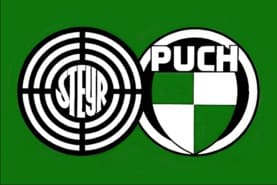STEYR-PUCH Truck PDF Manuals
Steyr-Puch Pinzgauer Trucks History
Above on the page there're some Service PDF Manuals & Spare Parts Catalogs for STEYR-PUCH Trucks.
In May 71, the first two-axle all-terrain vehicles Steyr-Puch Pinzgauer 710 had already entered the service of the Swiss army, and a year later they were joined by trucks on a three-axle chassis Steyr-Puch Pinzgauer 712.
The characteristics of the Steyr-Puch Pinzgauer went far beyond the conditions set by the Swiss army: the Steyr-Puch Pinzgauer 712 could transport 10 passengers or two standard NATO containers.
Other characteristics of the first generation Steyr-Puch Pinzgauer truck:
Gross weight - 3 and 3.9 tons (Steyr-Puch Pinzgauer 710 and 712 trucks);
Load capacity - 1 and 1.5 tons;
Towing - 5 tons on the road, 1.5 off-road;
Speed - 95-100 km / h;
The path on one gas station is 400 km (700 km with an additional tank of 125 liters).
The Pinzgauer 4-cylinder carburetor engine could not boast of power: 87 hp was in 2.5 liters.
But the thoughtful air cooling system in the spirit of Tatra, a low compression ratio (7.5) and several oil pumps worked for the durability of the motor.
The hydraulic brake drive was equipped with a vacuum booster.
The motor is located longitudinally, behind the front axle, which gives it better security and provides excellent weight distribution.
The maximum torque of 185 Nm was achieved by the engine at half the maximum speed - 2000 min-1.
The common transmission pipe half hides a 5-speed manual gearbox.
The pipe protects not only the box, but also the drive shafts, making repairs difficult, but making them practically inaccessible to impacts from the outside.
Rotation is transmitted through a pair of bevel gears with helical contact.
This engagement allows the suspension axle shafts to swing in a vertical plane: simultaneously with the transfer of force, the driven and driving gears could roll along a spiral contact.
The original design of the Steyr-Puch Pinzgauer truck chassis continues in the position of the axle shafts: the right ones are slightly shifted back, which is compensated by other elements without affecting handling.
In this unique suspension, the wheels can move 20 cm (not enough for diagonal suspension, but the high energy intensity of the suspension compensates for the disadvantage).
Portal bridges, copied from the legendary Unimog, made it possible to remove the load from the transmission and increase the ground clearance to 36 cm.
Pinzgauer differentials require minimal lubrication, but are easily able to regain control when slipping, because there are three of them (inter-axle and inter-wheel), and in an emergency they can be turned on right on the go (forced blocking is carried out through a hydraulic drive).
Due to the complete synchronization of the transfer case and gear shifting, on a normal road, the differential must be turned off.



